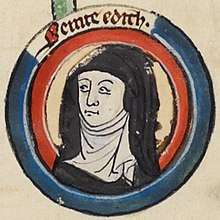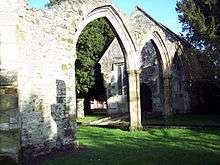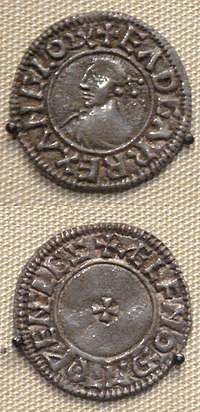Wulfthryth of Wilton
Wilfrida also known as Wulfthryth (died 1000), was a Catholic female saint and abbess from Anglo-Saxon England who was venerated locally in Wiltshire.
Primary sources
Wulfthryth is known to history through several sources, including the hagiography of the Secgan Manuscript,[1] John of Worcester’s Chronicle, William of Malmesbury,[2] Osburn’s life of Dunstan, the Life of St Wulfthryth found in The Wilton Chronicle,[3] A Royal Charter of King Edgar to Wulfthryth,[4] and the Vita Edithae by Goscelin.[5] The medieval source record her as living an exemplary life of sanctity and virtue and her virtues were often contrasted to the machinations of Edgar’s second (third?) wife, Ælfthryth.[6]
Life

Wulfthryth was an English noblewoman, a cousin of Wulfhild, born about 937, whom King Edgar of England carried off from the nunnery at Wilton Abbey and took to his residence at Kemsing, near Sevenoaks.[7] While in Kent, Wulfthryth gave birth to a daughter, Edith.[8]
After at least a year, Wulfthryth returned to Wilton Abbey, taking Edith with her.[9] She later became head of the abbey and outlived her daughter.
According to early monastic texts, under Saint Dunstan's direction Edgar did penance for this crime by not wearing his crown for seven years.[10] As part of his penance, Edgar gave Wilfrida six estates in Wiltshire and the Isle of Wight which she passed on to Wilton Abbey in 965AD.[11] Some form of bride abduction, often more simulated force than actual, by this time, may have existed as a vestige of earlier Anglo-Saxon tradition, and historians have alternatively referred to Wilfrida as Edgar's concubine or his second wife, although never as a captive. Given the religious customs of the time, his penance was probably related to his violation of the sanctity of her religious vocation, rather than to any personal affront to Wilfrida. It is clear that the two may have had a continuing friendship long after her return to Wilton. In any event, Edgar seems to have acknowledged Edith as his daughter; the relationship may have been considered a marriage, despite the formal church sanction, as was the custom of the time, and if so Edith was a legitimate daughter.
Wulfthryth continued to have considerable influence upon Edgar after her return to Wilton. She was able to stop bailiffs from arresting a thief who had taken sanctuary in the Abbey[12] and was able to secure the release of two Wilton priests who had been imprisoned by the reeve of Wilton.[13] As Abbess of Wilton, she built a stone wall around the Abbey and also used her wealth to build up the abbey's collection of relics.[14] Goscelin calls her the "hidden treasure and light" of the Abbey, and she was held in high esteem during her life.[15] and she is credited with miracles during her lifetime,[16] and Alms giving.[17]
Veneration

Both Wulfthryth and her daughter Edith were regarded as saints after their lifetimes.[18] Wulfthryth died at Wilton on 21 September, probably in the year 1000, and was buried before the main altar of the Wilton Abbey church.[19]
Her Feast Day is 13 September.
References

- Stowe MS 944, British Library.
- William of Malmesbury Gesta Regum Anglorum, Volume 2 (Oxford University Press, 1999)p.139).
- Wiesje Emons-Nijenhuis, The Embedded Saint, the Wilton Chronicle's Life of St Wulfthryth in Revue Bénédictine Volume 119, Number 1 Jun 2009
- Manuscript Sawyer 799
- Katherine O'Brien O'Keeffe, Stealing Obedience: Narratives of Agency and Identity in Later Anglo-Saxon England (University of Toronto Press, 2012) ebook.
- Katherine O'Brien O'Keeffe, Stealing Obedience: Narratives of Agency and Identity in Later Anglo-Saxon England (University of Toronto Press, 2012) ebook.
- Stephen Morillo, The Haskins Society Journal (Boydell Press, 2003), page 97
- Pauline Stafford, Queen Emma & Queen Edith (Blackwell, 2001), pp. 324-325
- Mrs Jameson, Legends of the monastic orders: as represented in the fine arts, p. 95
- Ann Williams, Oxford Dictionary of National Biography (Oxford University Press, 2004), (Edgar Pacificus), accessed 16 May 2012 (Subscription site)
- Wulfthryth at OxfordDNB (Subscription site)
- Stephen Morillo, The Haskins Society Journal (Boydell Press, 2003)page 112
- Gwen Seabourne, Imprisoning Medieval Women: The Non-judicial Confinement and Abduction of Women in England, c. 1170-1509 (Ashgate Publishing, Ltd., 2011) page 184
- Wulfthryth at OxfordDNB.
- A. Wilmart, La légende de Ste Édith en prose et vers par le moine Goscelin, Analecta Bollandiana, 56 (1938), 5–101, 265–307
- Wulfthryth at OxfordDNB.
- The Liber Vitae of the New Minster, Winchester Fol 26r.20 (901 x 904 - ?)
- Barbara Yorke, Oxford Dictionary of National Biography (Oxford University Press, 2004), (St Wulfthryth, abbess of Wilton) accessdate=17 November 2012
- Wulfthryth at OxfordDNB.